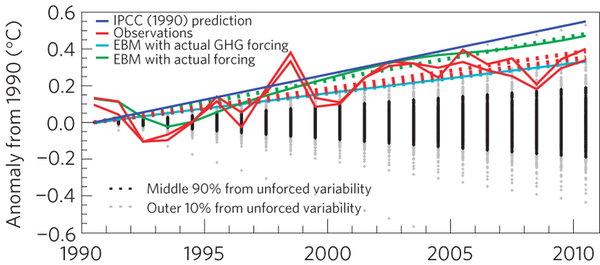 The solid and dashed lines show the annual variations; the dotted lines show best-fit linear trends. Trend and annual variations are plotted as anomalies from the 1990 value of the trend fit.
The solid and dashed lines show the annual variations; the dotted lines show best-fit linear trends. Trend and annual variations are plotted as anomalies from the 1990 value of the trend fit.
ABSTRACT: In 1990, climate scientists from around the world wrote the First Assessment Report of the Intergovernmental Panel on Climate Change. It contained a prediction of the global mean temperature trend over the 1990–2030 period that, halfway through that period, seems accurate. This is all the more remarkable in hindsight, considering that a number of important external forcings were not included. So how did this success arise? In the end, the greenhouse-gas-induced warming is largely overwhelming the other forcings, which are only of secondary importance on the 20-year timescale.
Assessment of the first consensus prediction on climate change
David J. Frame & Dáithí A. Stone
Nature Climate Change 3, 357–359 (2013) doi:10.1038/nclimate1763
Received 31 July 2012 Accepted 01 November 2012 Published online 09 December 2012
TY - JOUR
AU - Frame, David J.
AU - Stone, Daithi A.
TI - Assessment of the first consensus prediction on climate change
JA - Nature Clim. Change
PY - 2013/04//print
VL - 3
IS - 4
SP - 357
EP - 359
PB - Nature Publishing Group
SN - 1758-678X
UR - http://dx.doi.org/10.1038/nclimate1763
M3 - 10.1038/nclimate1763
N1 - 10.1038/nclimate1763
ER -
Read more ...
20-Year-Old Report Successfully Predicted Warming: Scientists (LiveScience)
Add Frame and Stone to the List of Papers Validating IPCC Warming Projections (Skeptical Science)
The IPCC was not right. Frame & Stone ignore main IPCC predictions (JoNova)
 The solid and dashed lines show the annual variations; the dotted lines show best-fit linear trends. Trend and annual variations are plotted as anomalies from the 1990 value of the trend fit.
The solid and dashed lines show the annual variations; the dotted lines show best-fit linear trends. Trend and annual variations are plotted as anomalies from the 1990 value of the trend fit.